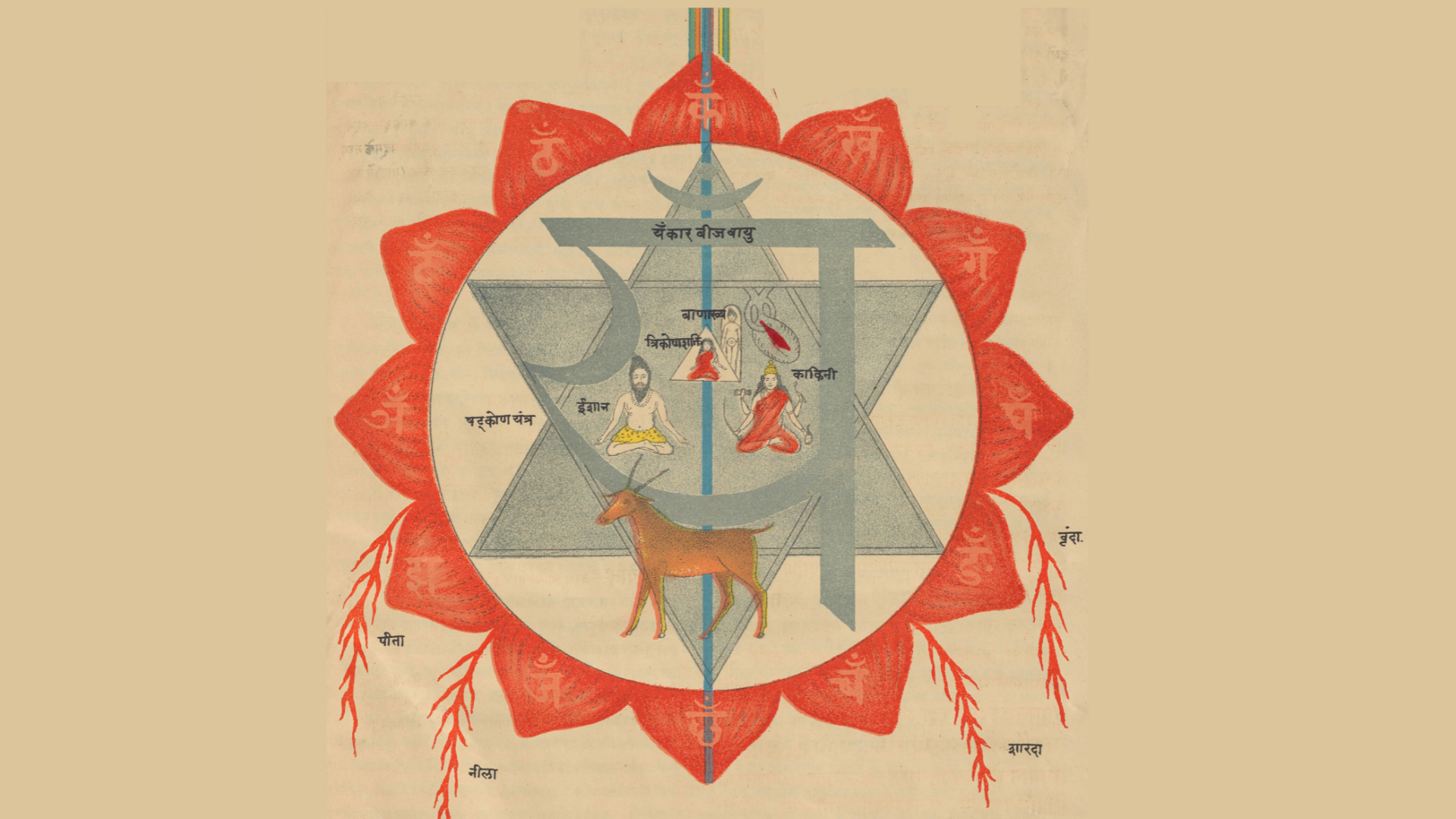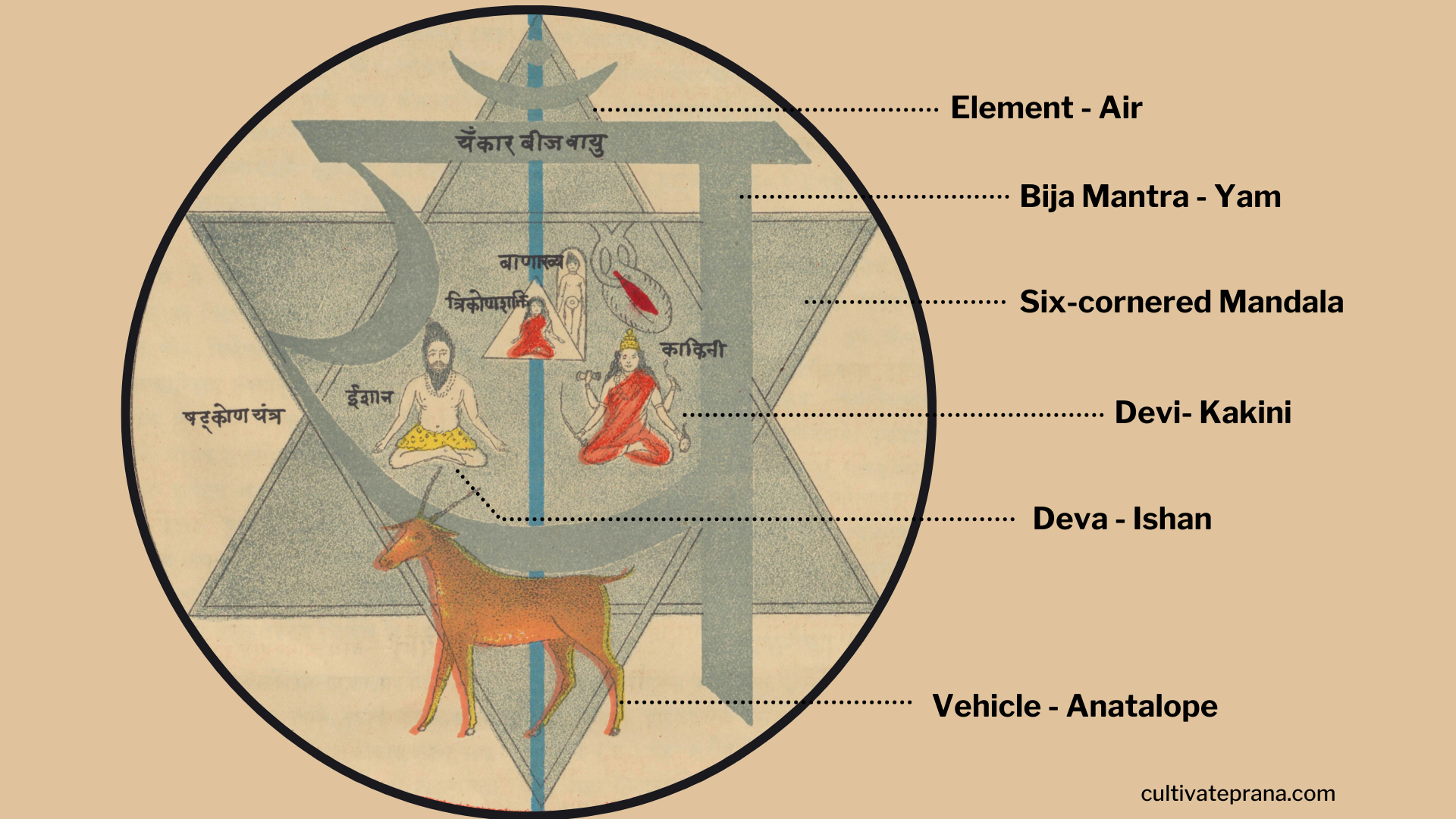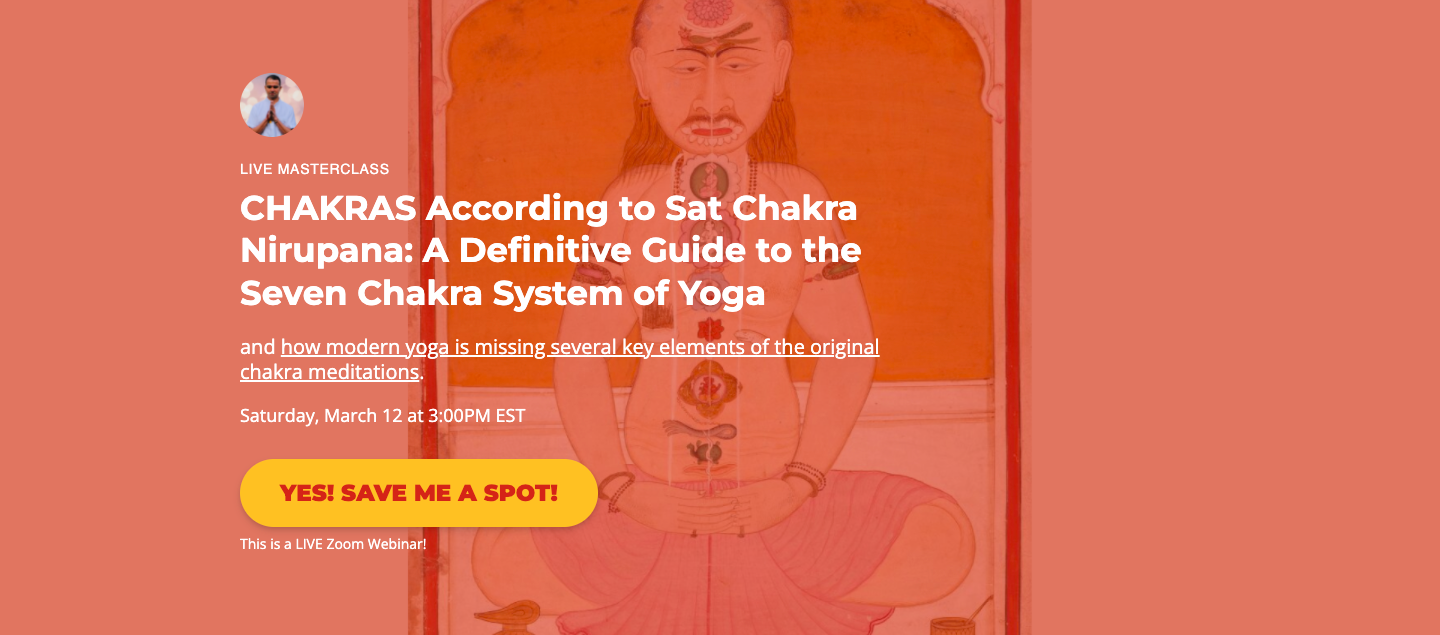Anahata Chakra: The abode of compassion, courage and desire
By Devendra Narayan, PhD.

Credit: MS Sanskrit 391. Authored by Svami Hamsasvarupa, 1900s. Wellcome Collection. The original image has been modified for use in this article.
- Anahata is the twelve-petalled, red-colored lotus (chakra) located in the heart.
- The masculine and feminine deities residing within the Anahata chakra are Ishan and Kakini.
- Anahata chakra is associated with the air element and is the abode of compassion, courage and all desires.
In previous articles, I have described the architecture of the Muladhara, Svadhisthana, and Manipura chakras according to the 16th century text Sat Chakra Nirupana. In this article, we continue our journey through the inner pilgrimage by exploring the architecture of the fourth sacred city, the Anahata chakra.
Anahata Chakra
Anahata chakra resides in the heart. It has twelve petals that shine like the red noon flower (Bandhuli). Each petal is adorned with a sanskrit letter in vermilion red. Kam, kham, gam, gham, nGam, cam, cham, jam, jham, njam, tam, and tham are the sounds associated with these letters.
Like the Kalpavrksa tree, the Anahata chakra grants all desires. In fact, Sat Chakra Nirupana says that the Anahata chakra is far more generous than the Kalpavrksa tree.

Credit: MS Sanskrit 391. Authored by Svami Hamsasvarupa, 1900s. Wellcome Collection. The original image has been modified for use in this article.
At the center of the Anahata chakra is the smoke-coloured six-cornered (shatkona) mandala of the air element (Vayu). This six-cornered mandala is formed by the intersection of an upward pointing triangle and a downward pointing triangle.
The six-cornered mandala contains the bija mantra, Yam, which is smoke-colored and rides an antelope. The male deity residing in the Anahata chakra is Lord Shiva's compassionate avatar, Ishan, adorned in white skin, filling the three worlds with a sense of well being by dispelling fear with the abhaya mudra in one hand and fulfilling desires with the Varada mudra in the other.
Kakini, the female deity next to Ishan, is three-eyed, shining like a thunderbolt, and wearing yellow garments and ornaments. It is she who bestows well-being on those who follow the path of righteousness. With a pleasant mind and heart filled with the nectar of immortality, she holds in her four hands a rope, skull, boon, and the root of a fragrant grass, and wears a garland of bones.

Credit: MS Sanskrit 391. Authored by Svami Hamsasvarupa, 1900s. Wellcome Collection. The original image has been modified for use in this article.
A triangular yantra, Trikona shakti, sits at the center of the Anahata chakra. Within this triangular yantra resides a three-eyed Devi shakti shining with the brightness of 10 million thunderbolts. Banakhya, a golden-colored Shiva lingam, is located to the left of the shakti. He is depicted in human form, decorated in kugkuma (saffron) with a hole at the top of his head. A secret eight-petaled lotus of Devi Lakshmi appears in this hole, shining with the brilliance of a diamond.
According to Sat Chakra Nirupana, a person who meditates on the Anahata chakra in the heart becomes empowered to protect and transform like Shiva himself. Like the Kalpavrksa tree, the Anahata chakra grants all wishes. Those who meditate on the Anahata become loving, gain control over sense organs, and master the art of concentration. He becomes a master of yoga (yogisha) and a master of knowledge (jjanisha), capable of creating beautiful poetry and compositions. He gains the ability to enter into another person's body.
Finally, one receives the highest rewards (Uttama Phala) by meditating on the secret door to the eight petal lotus of Lakshmi located within the opening of the Banakhya lingam.
The fifth inner sacred city, Vishuddhi chakra, will be discussed in the next article.
Major difference between the old and new interpretations of the chakras
In translating the architecture of the Anahata chakra described in Sat Chakra Nirupana, I noticed the differences between the ancient and modern depiction of the Anahata chakra. The Anahata chakra, for instance, is shown as green in the modern, hue-colored depiction of chakras. However, according to Sat Chakra Nirupana, the petals of Anahata chakra are red and the six-cornered mandala of Vayu is smoke-colored.
I also noticed that Swami Hansa Swaroop's Anahata chakra drawing has a heart on the left side of the six-cornered mandala. There is only one chakra on which an anatomical part is depicted. Is this to say that Anahata is not inside the heart but that the heart is inside Anahata? According to the latter, Anahata is much bigger than any other chakra in the body. Contemporary science has confirmed this by showing that the electromagnetic field of the heart is much larger than previously thought [2].
Furthermore, I noticed that in Arthur Avalon's translation of Sat Chakra Nirupana [3], the Triangle of Trikona Shakti is pointing downwards, whereas in Swami Hansa Swaroop's translation, it is pointing upwards. In Tantra, it is significant which direction a triangle is pointing. So which version is correct? I have yet to discover.
About the Author
Devendra Narayan is a scientist, yoga teacher, breathworker, scholar and founder of Cultivate Prana Academy. Cultivate Prana's mission is to empower modern day healers through education that integrates ancient wisdom and modern science.
Reference:
- Svāmihaṃsasvarūpakr̥tam Ṣaṭcakranirūpaṇacitram : bhāṣyasamalaṃkr̥taṃ bhāṣāṭīkopetañ ca = Shatchakra niroopana chittra with bhashya and bhasha containing the pictures of the different nerves and plexuses of the human body with their full description showing the easiest method how to practise pranayam by the mental suspension of breath through meditation only ; by Shri Swami Hansa Swaroop.
- https://www.heartmath.org/research/science-of-the-heart/energetic-communication/
- The Serpent Power: The Secrets of Tantric and Shaktic Yoga by Arthur Avalon. Dover Publications, Inc. 1974. Page 381
-------
Copyright 2021 Cultivate Prana. All rights reserved.

